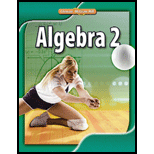
Concept explainers
a.
To write: a matrix to represent the transitions in city population and suburb population.
a.
Answer to Problem 36PPS
Explanation of Solution
Given information:
The annual percentage migration from city to city is 0.95.
The annual percentage migration from city to suburbs is 0.05.
The annual percentage migration from suburbs to city is 0.03.
The annual percentage migration from suburbs to suburbs is 0.97.
Formula used:
A matrix is a rectangular array of variables or constants in horizontal rows and vertical columns, enclosed in brackets.
Calculation:
Let x = the number of people who live in city.
Let y = the number of people who live in suburbs.
Therefore, we get the following system of equations:
The matrix states that :
Hence, the matrix is formed.
b.
To calculate: The number of people who will live in the suburbs next year.
b.
Answer to Problem 36PPS
The total number of people living in suburbs next year will be 17,839.
Explanation of Solution
Given information:
The annual percentage migration from city to city is 0.95.
The annual percentage migration from city to suburbs is 0.05.
The annual percentage migration from suburbs to city is 0.03.
The annual percentage migration from suburbs to suburbs is 0.97.
Currently, there are 16,275 people living in the city and 17, 552 people living in the suburbs.
Formula used:
Multiplying Matrices :
Calculation:
According to the question we have,
Let x = the number of people living in the city
Let y = the number of people living in the suburbs.
Hence, the total number of people living in suburbs next year will be 17,839.
c.
To calculate: a inverse matrix to find the number of people lived in the city last year.
c.
Answer to Problem 36PPS
16587people lived in the city last year.
Explanation of Solution
Given information:
Formula used:
Inverse of a
The value of a second order determinant is the difference of the products of the products of the two diagonals.
Steps to solve the equations are:-
Step1. Find the inverse of the coefficient matrix.
Step 2. Multiple each side of the matrix equation by the inverse matrix.
Calculation:
Step 1.
Since the determinant does not equal to 0,
Step 2.
Step3.
Or
Hence, about 16587 people lived in the city last year.
Chapter 4 Solutions
Algebra 2
Additional Math Textbook Solutions
A Problem Solving Approach To Mathematics For Elementary School Teachers (13th Edition)
Thinking Mathematically (6th Edition)
Intro Stats, Books a la Carte Edition (5th Edition)
A First Course in Probability (10th Edition)
Algebra and Trigonometry (6th Edition)
Basic Business Statistics, Student Value Edition
- 1. vector projection. Assume, ER1001 and you know the following: ||||=4, 7=-0.5.7. For each of the following, explicitly compute the value. འབ (a) (b) (c) (d) answer. Explicitly compute ||y7||. Explain your answer. Explicitly compute the cosine similarity of and y. Explain your Explicitly compute (x, y). Explain your answer. Find the projection of onto y and the projection of onto .arrow_forward2. Answer the following questions using vectors u and v. --0-0-0 = find the the cosine similarity and the angle between u and v. འརྒྱ (a) (b) find the scalar projection of u onto v. (c) find the projection of u onto v. (d) (e) (f) find the scalar projection of onto u. find the projection of u onto u. find the projection of u onto and the projection of onto . (Hint: find the inner product and verify the orthogonality)arrow_forwardPlease type out answerarrow_forward
- The function f(x) = log x is transformed to produce g(x) = log (x) – 3. Identify the type of transformation and describe the change. Please type out answerarrow_forwardEach graph below is the graph of a system of three linear equations in three unknowns of the form Ax = b. Determine whether each system has a solution and, if it does, the number of free variables. A. O free variables ✓ B. no solution C. no solution D. no solution E. 1 free variable F. 1 free variablearrow_forwardSolve the following systems of equations and show all work.y = x2 + 3y = x + 5 Please type out answerarrow_forward
- Solve the following system of equations. Show all work and solutions.y = 2x2 + 6x + 1y = −4x2 + 1 Please type out answerarrow_forwardDalia buys 20 collectible gems per month. Grace sells 10 gems from her collection of 120 each month. When will Dalia have more gems than Grace? Show your work. Dear Student If You Face any issue let me know i will solve your all doubt. I will provide solution again in more detail systematic and organized way. I would also like my last 3 questions credited to mearrow_forwardDalia buys 20 collectible gems per month. Grace sells 10 gems from her collection of 120 each month. When will Dalia have more gems than Grace? Show your work.arrow_forward
 Algebra and Trigonometry (6th Edition)AlgebraISBN:9780134463216Author:Robert F. BlitzerPublisher:PEARSON
Algebra and Trigonometry (6th Edition)AlgebraISBN:9780134463216Author:Robert F. BlitzerPublisher:PEARSON Contemporary Abstract AlgebraAlgebraISBN:9781305657960Author:Joseph GallianPublisher:Cengage Learning
Contemporary Abstract AlgebraAlgebraISBN:9781305657960Author:Joseph GallianPublisher:Cengage Learning Linear Algebra: A Modern IntroductionAlgebraISBN:9781285463247Author:David PoolePublisher:Cengage Learning
Linear Algebra: A Modern IntroductionAlgebraISBN:9781285463247Author:David PoolePublisher:Cengage Learning Algebra And Trigonometry (11th Edition)AlgebraISBN:9780135163078Author:Michael SullivanPublisher:PEARSON
Algebra And Trigonometry (11th Edition)AlgebraISBN:9780135163078Author:Michael SullivanPublisher:PEARSON Introduction to Linear Algebra, Fifth EditionAlgebraISBN:9780980232776Author:Gilbert StrangPublisher:Wellesley-Cambridge Press
Introduction to Linear Algebra, Fifth EditionAlgebraISBN:9780980232776Author:Gilbert StrangPublisher:Wellesley-Cambridge Press College Algebra (Collegiate Math)AlgebraISBN:9780077836344Author:Julie Miller, Donna GerkenPublisher:McGraw-Hill Education
College Algebra (Collegiate Math)AlgebraISBN:9780077836344Author:Julie Miller, Donna GerkenPublisher:McGraw-Hill Education





